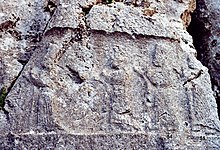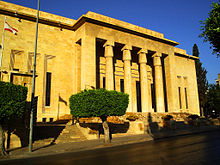Portal:Phoenicia
THE PHOENICIA PORTAL

Phoenicia (/fəˈnɪʃə, fəˈniːʃə/), or Phœnicia, was an ancient Semitic thalassocratic civilization originating in the coastal strip of the Levant region of the eastern Mediterranean, primarily located in modern Lebanon. The territory of the Phoenicians expanded and contracted throughout history, with the core of their culture stretching from Arwad in modern Syria to Mount Carmel in modern Israel covering the entire coast of modern Lebanon. Beyond their homeland, the Phoenicians extended through trade and colonization throughout the Mediterranean, from Cyprus to the Iberian Peninsula.
The Phoenicians directly succeeded the Bronze Age Canaanites, continuing their cultural traditions following the decline of most major cultures in the Late Bronze Age collapse and into the Iron Age without interruption. It is believed that they self-identified as Canaanites and referred to their land as Canaan, indicating a continuous cultural and geographical association. The name Phoenicia is an ancient Greek exonym that did not correspond precisely to a cohesive culture or society as it would have been understood natively. Therefore, the division between Canaanites and Phoenicians around 1200 BC is regarded as a modern and artificial division.
The Phoenicians, known for their prowess in trade, seafaring and navigation, dominated commerce across classical antiquity and developed an expansive maritime trade network lasting over a millennium. This network facilitated cultural exchanges among major cradles of civilization like Greece, Egypt, and Mesopotamia. The Phoenicians established colonies and trading posts across the Mediterranean; Carthage, a settlement in northwest Africa, became a major civilization in its own right in the seventh century BC.
The Phoenicians were organized in city-states, similar to those of ancient Greece, of which the most notable were Tyre, Sidon, and Byblos. Each city-state was politically independent, and there is no evidence the Phoenicians viewed themselves as a single nationality. While most city-states were governed by some form of kingship, merchant families likely exercised influence through oligarchies. After reaching its zenith in the ninth century BC, the Phoenician civilization in the eastern Mediterranean gradually declined due to external influences and conquests. Yet, their presence persisted in the central and western Mediterranean until the destruction of Carthage in the mid-second century BC. — Read more about Phoenicia, its mythology and language
 Featured article
•
Featured article
•
A Featured article represents some of the best content on Wikipedia
The Battle of the Aegates was a naval battle fought on 10 March 241 BC between the fleets of Carthage and Rome during the First Punic War. It took place among the Aegates Islands, off the western coast of the island of Sicily. The Carthaginians were commanded by Hanno, and the Romans were under the overall authority of Gaius Lutatius Catulus, but Quintus Valerius Falto commanded during the battle. It was the final and deciding battle of the 23-year-long First Punic War.
The Roman army had been blockading the Carthaginians in their last strongholds on the west coast of Sicily for several years. Almost bankrupt, the Romans borrowed money to build a naval fleet, which they used to extend the blockade to the sea. The Carthaginians assembled a larger fleet which they intended to use to run supplies into Sicily. It would then embark much of the Carthaginian army stationed there as marines. It was intercepted by the Roman fleet and in a hard-fought battle, the better-trained Romans defeated the undermanned and ill-trained Carthaginian fleet, which was further handicapped by being laden with supplies and having not yet embarked its full complement of marines. (Full article...)Phoenician mythology •
Images
 Good article
•
Good article
•
A Good article meets a core set of high editorial standards
The National Museum of Beirut (Arabic: متحف بيروت الوطنيّ, Matḥaf Bayrūt al-waṭanī) is the principal museum of archaeology in Lebanon. The collection begun after World War I, and the museum was officially opened in 1942. The museum has collections totaling about 100,000 objects, most of which are antiquities and medieval finds from excavations undertaken by the Directorate General of Antiquities.
During the 1975 Lebanese Civil War, the museum stood on the front line that separated the warring factions. The museum's Egyptian Revival building and its collection suffered extensive damage in the war, but most of the artifacts were saved by last-minute preemptive measures. (Full article...)Phoenician inscriptions & language •
The Baal Lebanon inscription, known as KAI 31, is a Phoenician inscription found in Limassol, Cyprus in eight bronze fragments in the 1870s. At the time of their discovery, they were considered to be the second most important finds in Semitic palaeography after the Mesha stele.
It was purchased in 1874–75 by a Limassol merchant named Laniti from a scrap metal dealer, who did not know of their previous provenance. A copy was passed to Julius Euting, and after Charles Simon Clermont-Ganneau secured its acquisition by the Cabinet des Médailles, the inscription was published in full by Ernest Renan in 1877.
It is particularly notable for having mentioned Hiram I. It is the only Phoenician inscription to suggest a "colonial" system amongst the Phoenician domains. (Full article...)Did you know (auto-generated) •

- ... that coins issued by Baalshillem II, the Phoenician king of Sidon, were the first Sidonian coins to bear minting dates corresponding to the king's year of reign?
- ... that Bochart's 1646 Geographia Sacra seu Phaleg et Canaan was the first full-length book devoted to the Phoenicians?
- ... that the discovery of Phoenician metal bowls in 1849 created the entire concept of Phoenician art?
- ... that the earliest-known Phoenician inscriptions were found near Bethlehem?
- ... that archaeological excavations in the historic town of Kharayeb revealed a rural settlement with a complex system of cisterns and a Phoenician temple?
- ... that the deity of the Phoenician sanctuary of Kharayeb remains unidentified due to the absence of names of specific gods in unearthed inscriptions?
Related portals
Categories
Wikiproject
Other Wikimedia and Wikiportals
The following Wikimedia Foundation sister projects provide more on this subject:
-
Commons
Free media repository -
Wikibooks
Free textbooks and manuals -
Wikidata
Free knowledge base -
Wikinews
Free-content news -
Wikiquote
Collection of quotations -
Wikisource
Free-content library -
Wikiversity
Free learning tools -
Wikivoyage
Free travel guide -
Wiktionary
Dictionary and thesaurus
Parent portal: Lebanon














































